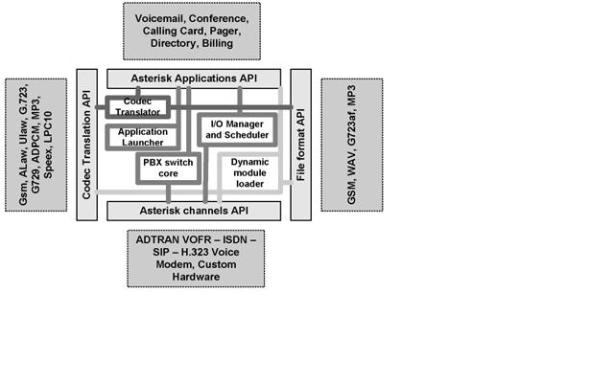Asterisk is an “Open Source PBX software” that once installed in a PC hardware along with the correct interfaces, can be used as a full featured PBX for home users, enterprises, VoIP service providers and telecoms. Asterisk is also both an Open Source Community and a commercial product from Digium. You are free to use and modify Asterisk to suit your needs.
Asterisk is middleware that connects Internet and telephony technologies with Internet and telephony applications. Asterisk applications connect any phone, phone line or packet voiceconnection to another interface or service. Asterisk scales easily and reliably from very small tovery large systems.
Asterisk supports high density, redundant applications. Asterisk supports every possible kind of telephone technology. These technologies include VoIP, SIP, H.323, IAX, and MGCP (for gateways and phone). Asterisk can interoperate with almost all-standards telephony equipment.The hardware required to connect your Asterisk systemis inexpensive. Asterisk supports traditional telephone technologies like ISDN PRI and Tcarrier including T1 and E1. Telephony applications include calling, conferencing, call bridging, voicemail, auto attendant, custom Interactive Voice Response (IVR) scripting, call parking, intercom, and many others. An Asterisk server connected to a Local Area Network (LAN) can control phones connected to that LAN. These phones can call each other through the Asterisk server. The Asterisk server can control phones connected to other networks or the Internet, even if those phones or the Asterisk server are behind firewalls. With Digium FXS interface cards, an Asterisk server can control local analog telephones. FXO and Tcarrier interface boards from Digium can connect an Asterisk server to the PSTN. This allows calls to be made to and from the PSTN. PSTN users can call phones controlled by the Asterisk server; Asterisk phones can call users on the PSTN.
Calls can be switched from one Asterisk server to another. A telephone controlled by an Asterisk server can call a telephone controlled by a second Asterisk server. A call from a telephone controlled by one Asterisk server can be switched to a second Asterisk server and then on to the PSTN.
Asterisk contains engines that perform critical functions. When Asterisk starts, the Dynamic Module Loader loads and initializes drivers. The drivers provide channel drivers, file formats, call detail recording back-ends, codecs, and applications among others. The Asterisk PBX Switch Core accepts telephone calls from the interfaces. It handles calss according to the instructions found dial plan. It uses the Application Launcher to ring phones, to connect to voicemail or dial out on outbound trunks. The PBX Switch Core includes a Scheduler and I/O Manager that is available to drivers and applications. The Codec Translator seamlessly connects channels compressed with different codecs. Most of Asterisk’s flexibility comes from the applications, codecs, channel drivers, file formats and other facilities’ interaction with the various programming interfaces.
